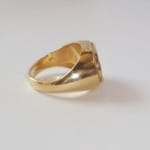Gold Ring Featuring a Classical Revival Carnelian Intaglio of Cupid, 18th Century CE
Carnelian, Gold
FJ.6780
This Gorgeous Seal Has Been Mounted in a Modern 18 Karat Gold Rin The art of glyptics, or carving on colored precious stones, is probably one of the oldest known...
This Gorgeous Seal Has Been Mounted in a Modern 18 Karat Gold Rin
The art of glyptics, or carving on colored precious stones, is probably one of the oldest known to humanity. Intaglios, gems with an incised design, were made as early as the fourth and third millennia B.C. in Mesopotamia and the Aegean Islands. The exhibit a virtuosity of execution that suggests an old and stable tradition rooted in the earliest centuries. The tools required for carving gems were simple: a wheel with a belt-drive and a set of drills. Abrasives were necessary since the minerals used were too hard for a metal edge. A special difficulty of engraving intaglios, aside from their miniature size, was that the master had to work with a mirror-image in mind.
The Classical Revival was a phenomenon that swept through Europe in the 18th and 19th Centuries. A new appreciation for antiquity and ancient art forms was fostered by discoveries in the nascent scientific field of archaeology. Perhaps the Classical Revival also reveals a latent longing towards the Arcadian lifestyles of yesterday abandoned as Europe became rapidly industrialized and increasingly urbanized. On this stunning intaglio, the mischievous god of love Cupid is depicted riding on a sea horse. Although the front of this animal, including the legs, is reminiscent of an actual stallion, the spiraling tail and lack of hind legs indicates this is a marine creature. Seahorses frequently appear in mythology, often pulling the chariot of the sea god Neptune. This unique seal harkens back to another era and a time when mankind, nature, and the gods were all intertwined. Today, it remains a stunning example of artistry imitating the classic examples of the past.
The art of glyptics, or carving on colored precious stones, is probably one of the oldest known to humanity. Intaglios, gems with an incised design, were made as early as the fourth and third millennia B.C. in Mesopotamia and the Aegean Islands. The exhibit a virtuosity of execution that suggests an old and stable tradition rooted in the earliest centuries. The tools required for carving gems were simple: a wheel with a belt-drive and a set of drills. Abrasives were necessary since the minerals used were too hard for a metal edge. A special difficulty of engraving intaglios, aside from their miniature size, was that the master had to work with a mirror-image in mind.
The Classical Revival was a phenomenon that swept through Europe in the 18th and 19th Centuries. A new appreciation for antiquity and ancient art forms was fostered by discoveries in the nascent scientific field of archaeology. Perhaps the Classical Revival also reveals a latent longing towards the Arcadian lifestyles of yesterday abandoned as Europe became rapidly industrialized and increasingly urbanized. On this stunning intaglio, the mischievous god of love Cupid is depicted riding on a sea horse. Although the front of this animal, including the legs, is reminiscent of an actual stallion, the spiraling tail and lack of hind legs indicates this is a marine creature. Seahorses frequently appear in mythology, often pulling the chariot of the sea god Neptune. This unique seal harkens back to another era and a time when mankind, nature, and the gods were all intertwined. Today, it remains a stunning example of artistry imitating the classic examples of the past.



